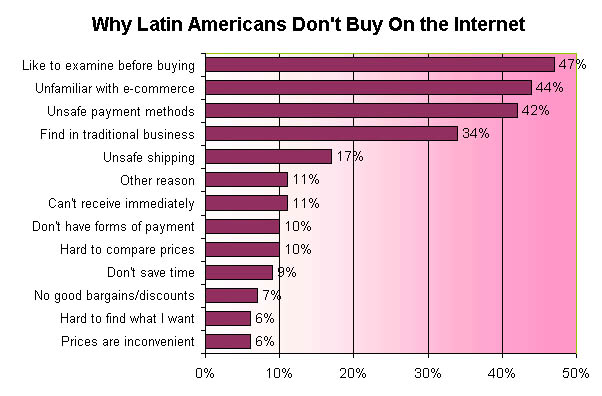
(source: TGI.net Latina)
Why Latin Americans Buy
(or not Buy) over the Internet
One of the lessons that are not well-learned is this: Just because you build a road does not mean that people will want to use it. There are other factors that will affect usage. As case evidence, just contemplate the Autopista del Sol, the well-graded four-lane highway linking Acapulco to Mexico City, which is sparsely used because of what is considered one of the world's highest toll charges.
The Internet has been somewhat more fortunate, since it was not built for a single purpose (such as carrying automobile traffic between two points). The infrastructure can therefore be re-purposed if the original model failed to live up to expectations. Perhaps the greatest expectations were invested with e-commmerce. As it turned out, even though e-commerce grew at exponential rates, the revenue was insufficient to sustain the many competitors, thus leading to the recent retrenchment.
The important thing to learn from this is why e-commerce did not grow even faster. To learn why, we need to know why some consumers embraced e-commerce and why others did not. We will now cite some data from the TGI.net Latina study, which was conducted in Argentina, Brazil, Chile, Colombia and Mexico. The base of this study was 5,423 persons between the ages of 12 and 64 years old who claimed to have used the Internet within the past 90 days. Of these, 15% said that they had made internet purchases over the past 6 months and 85% said that they had not done so.
The first question is: What reasons do the internet purchasers give? If we summarize in brief, the attraction of the internet purchasing is that it is easy to find reasonably priced products which can be conveniently bought and delivered with minimum effort.

(source: TGI.net Latina)
And what reasons do internet non-purchasers give? To summarize in brief, people don't buy on the internet for two reasons (1) issues about paying for e-commerce and (2) the unreality of virtual products which cannot be examined in person at brick-and-mortar outlets.

(source: TGI.net Latina)
Of course, the matter complicated than this top-of-line summary would indicate. After all, e-commerce is not a monolithic entity since multitudinous products and services are being peddled. For example, some products may be commodified such that in-person examination is unnecesary, while new products may require some convincing in person.
![]()
LINKS
(posted by Roland Soong, 6/8/2001)
(Return to Zona Latina's Home Page)